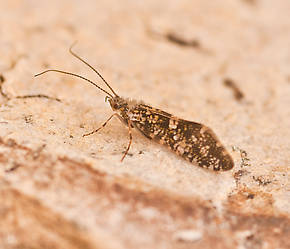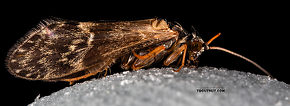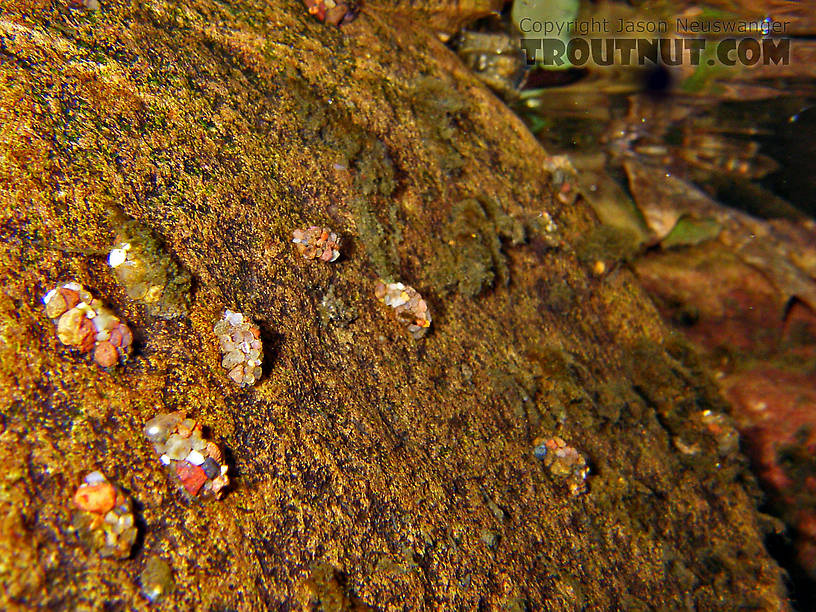Blog & Latest Updates
Fly Fishing Articles
Insects by Common Name


Caddisfly Family Glossosomatidae (Saddle-case Makers)
Taxonomic Navigation -?-
Kingdom
Animalia (Animals)
» Phylum
Arthropoda (Arthropods)
» Class
Insecta (Insects)
» Order
Trichoptera (Caddisflies)
» Family Glossosomatidae (Saddle-case Makers)
| Genus in Glossosomatidae | ||
| Agapetus | 0 | 0 |
| GlossosomaLittle Brown Short-horned Sedges | 2 | 11 |
| ProtoptilaPseudo-Microcaddisflies | 0 | 0 |
3 genera aren't included.
Common Name
| Match | Common Name |
| Saddle-case Makers |
Protoptila (Tiny Spotted Short-horned Caddis) is rarely important in trout streams and is generally found in warmer, larger water than the other two genera.
Agapetus (Tiny black Short-horned Caddis) is quite common in many northern streams.
Matrioptila is an extremely tiny southern genus.
Pictures of 2 Saddle-case Maker Specimens:
Glossosoma (Little Brown Short-horned Sedges) Saddle-case Maker Adult View 1 Pictures
View 1 Pictures
 View 1 Pictures
View 1 PicturesCollected March 13, 2010 from the Big Thompson River in Montana
Added to Troutnut.com by Bnewell on June 26, 2011
Added to Troutnut.com by Bnewell on June 26, 2011
Male Glossosoma alascense Saddle-case Maker Adult View 8 PicturesI lost track of this specimen before I could get it under my microscope, but caddis expert Dave Ruiter was able to identify it from pictures as Glossosoma, with an uncertain suggestion of G. alascense as the most likely species.
View 8 PicturesI lost track of this specimen before I could get it under my microscope, but caddis expert Dave Ruiter was able to identify it from pictures as Glossosoma, with an uncertain suggestion of G. alascense as the most likely species.
 View 8 PicturesI lost track of this specimen before I could get it under my microscope, but caddis expert Dave Ruiter was able to identify it from pictures as Glossosoma, with an uncertain suggestion of G. alascense as the most likely species.
View 8 PicturesI lost track of this specimen before I could get it under my microscope, but caddis expert Dave Ruiter was able to identify it from pictures as Glossosoma, with an uncertain suggestion of G. alascense as the most likely species.3 Underwater Pictures of Saddle-case Makers:

Three big Ephemerella subvaria mayfly nymphs share a rock with some cased caddis larvae.
In this picture: Mayfly Species Ephemerella subvaria (Hendrickson) and Saddle-case Maker Genus Glossosoma (Little Brown Short-horned Sedges).
In this picture: Mayfly Species Ephemerella subvaria (Hendrickson) and Saddle-case Maker Genus Glossosoma (Little Brown Short-horned Sedges).
StateWisconsin
LocationNamekagon River
Date TakenMar 20, 2004
Date AddedJan 25, 2006
AuthorTroutnut
CameraOlympus C740UZ

These are glossosomatids, Jason. They are probably Glossosoma nigrior, though it is possible that we are looking at mixed species. The ones to the right with their aggregate of similar sized grains are classic Glossosoma, while the ones to the left with the large anchor pebbles could possibly be Agapetus. Regardless, they're all commonly referred to as saddle case makers.
In this picture: Caddisfly Family Glossosomatidae (Saddle-case Makers).
In this picture: Caddisfly Family Glossosomatidae (Saddle-case Makers).
StateWisconsin
LocationSpring Creek
Date TakenJun 22, 2006
Date AddedJul 1, 2006
AuthorTroutnut
CameraPENTAX Optio WPi

StateNew York
LocationEast Branch of Trout Brook
Date TakenSep 20, 2006
Date AddedOct 4, 2006
AuthorTroutnut
CameraPENTAX Optio WPi
Recent Discussions of Glossosomatidae
Glossosoma intermedium or nigrior 5 Replies »
Posted by Wiflyfisher on Jun 30, 2020 in the genus Glossosoma
Last reply on Jul 31, 2020 by Creno
Caught and photographed in the Upper Midwest on May 12, 2020. I resized my original photo for the website.
(User-posted images are only viewable in the forum section.)
Replypupa color 7 Replies »(User-posted images are only viewable in the forum section.)
Posted by LittleJ on Apr 19, 2008 in the genus Glossosoma
Last reply on Apr 22, 2008 by LittleJ
I was thinking very dark olive w/a ginger shuck. Sound right to any of you?
thanks
jeff
ReplyAgapetus are EVERYWHERE!!!! 1 Reply »thanks
jeff
Posted by Litobrancha on Apr 12, 2007
Last reply on Apr 12, 2007 by GONZO
Jason
just wanted to spread the word about agapetus. many trout streams have healthy populations of agapetus and there is no reason that some of these species are important to early season emerger/dry fly fishing. small (#18-22) black caddis dry or emerger patterns will mimic them nicely, as well as Dolophilodes Wormaldia and Chimarra.
my colleagues are describing 12 new species of agapetus, mostly from the southeastern united states. i would encourage troutnuts to attempt to collect and rear agapetus pupae. it is pretty easy to do, find pupating cases and remove them from the rocks using forceps and into a small jar of water. If you use a jar with a small amount of water (just a little bit more than required to cover the pupae, removing the small stones around the puparium), then they will pupate in a refrigerator (preferably 60 C or so). Leave the lid loose to allow oxygen to equilibrate with the pupae. This also works for Rhyacophila, which build a similar puparium. We are describing new species of both Agapetus and Rhyacophila and it would be great to have specimens from Troutnuts!!! if interested in doing this, and it is time, email me litobrancha@yahoo.com You can send them to me in alcohol, who knows what else is out there!!!!
Replyjust wanted to spread the word about agapetus. many trout streams have healthy populations of agapetus and there is no reason that some of these species are important to early season emerger/dry fly fishing. small (#18-22) black caddis dry or emerger patterns will mimic them nicely, as well as Dolophilodes Wormaldia and Chimarra.
my colleagues are describing 12 new species of agapetus, mostly from the southeastern united states. i would encourage troutnuts to attempt to collect and rear agapetus pupae. it is pretty easy to do, find pupating cases and remove them from the rocks using forceps and into a small jar of water. If you use a jar with a small amount of water (just a little bit more than required to cover the pupae, removing the small stones around the puparium), then they will pupate in a refrigerator (preferably 60 C or so). Leave the lid loose to allow oxygen to equilibrate with the pupae. This also works for Rhyacophila, which build a similar puparium. We are describing new species of both Agapetus and Rhyacophila and it would be great to have specimens from Troutnuts!!! if interested in doing this, and it is time, email me litobrancha@yahoo.com You can send them to me in alcohol, who knows what else is out there!!!!
There are 1081 more topics.
Your Thoughts On Glossosomatidae:
Top 10 Fly Hatches
Top Gift Shop Designs
Eat mayflies.
Top Insect Specimens
Miscellaneous Sites
Troutnut.com is copyright © 2004-2024 Jason
Neuswanger (email Jason). See my FAQ for information about use of my images.
 privacy policy
privacy policy
